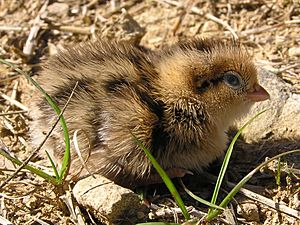Precocial facts for kids

Imagine baby animals that are ready to go almost as soon as they're born or hatched! That's what precocial means in biology. It's a way that different animal species grow and develop. These young animals are quite mature and can move around right away. This idea mainly applies to mammals and birds.
The opposite way of developing is called altricial. This is when young animals are born or hatched very helpless. They need a lot of care from their parents. Think of it like a sliding scale: some animals are super precocial, some are super altricial, and many are somewhere in between. For tiny creatures like invertebrates (animals without backbones), they often use metamorphosis. This means they change completely through different life stages, like a caterpillar turning into a butterfly.
Contents
What Makes a Baby Animal Precocial?
Scientists use a simple checklist to decide if a species is more precocial or altricial. If the answer is "yes" to these questions, the animal is likely precocial:
- Does the baby have down (soft feathers) or fur when it's born or hatched?
- Are its eyes open?
- Can it move around easily on its own?
- Can it find its own food?
- Do its parents need to be there all the time to feed and protect it? (For precocial, parents are less needed for constant feeding).
Birds: Ready to Fly (or Run!)
The difference between precocial and altricial is very clear in birds. Precocial bird babies leave the nest very soon after hatching.
Some birds, like the Megapodes found in Australasia, are super-precocial. Their parents don't even sit on the eggs to keep them warm. Instead, they bury the eggs in compost or sand. The male bird might check the temperature of the heap and make small changes. These eggs have a huge yolk, which is like a big lunchbox for the growing chick. When they hatch, they already have full wing feathers! These tiny birds can run and chase prey right away. Many can even fly on their very first day!
On the other hand, some of the smartest birds are altricial. This includes passerines (like crows), hawks, owls, and parrots. Their babies are born helpless and need a lot of parental care.
Mammals: From Running to Pouches
Mammal babies never feed themselves right away. They all drink their mother's milk. But there's a big difference in how quickly they become independent.
Think about a new-born deer or antelope. They can stand up and run within an hour or so of being born! That's very precocial. Now compare that to a baby marsupial (like a kangaroo). It's born tiny and undeveloped, then crawls into its mother's pouch. It stays there for days or weeks, growing and developing before it's ready to come out.
Humans are also a special case among advanced mammals. Human babies need a very long time before they can be independent. This is partly because our brains need to grow and mature a lot after birth. Also, humans learn a great deal from their parents and others, rather than relying mostly on instincts like many other mammals. Baby carnivores (meat-eaters) also take a long time to learn how to hunt. Large herd animals like elephants also have a lot to learn from their families.
Why Different Ways of Growing?
The different ways animals develop (precocial or altricial) are like a trade-off. Each way has its good points and bad points.
Altricial babies need a lot of time and care from their parents. They are also in constant danger from predation (being hunted by other animals). However, this system allows them a long time to learn from their parents. Also, their brains can grow more after birth because their parents provide rich food.
Precocial babies need more preparation before birth, often in larger eggs. But they are less open to predation and need less parental care after birth. Their brains are more ready to go at birth, but they might end up being smaller compared to their body size.
Scientists believe these different ways of growing evolved to help animals survive in their environment. It's about balancing the need to feed the young and protect them from danger. Birds and mammals have found different solutions to these challenges.
Humans: A Special Case
Humans are quite unique. A human baby needs a lot of care from its parents both before and after birth. A new-born baby might look somewhat precocial with its hair, open eyes, and large head. But most of its body parts aren't fully working yet. A human baby is completely helpless on its own.
The main reason for this is that a baby's cerebral cortex (the part of the brain responsible for thinking and learning) isn't fully developed at birth. Nerves are still growing. For the first 18 months, the cortex grows and starts to work properly. Then, after about 18 months to two years, babies start to learn language. From then on, their learning really takes off!
There's a good reason why a baby's brain isn't more developed at birth. During natural birth, the baby's head has to fit through the mother's birth canal, which is a space between the bones of her pelvis. If the baby's head were any larger, it wouldn't be able to get through.
This human way of developing has a cost. It means that parents can usually raise fewer children compared to animals that have many precocial offspring.
Images for kids
-
A human baby. Humans are known as altricial organisms because their babies are born very dependent.




